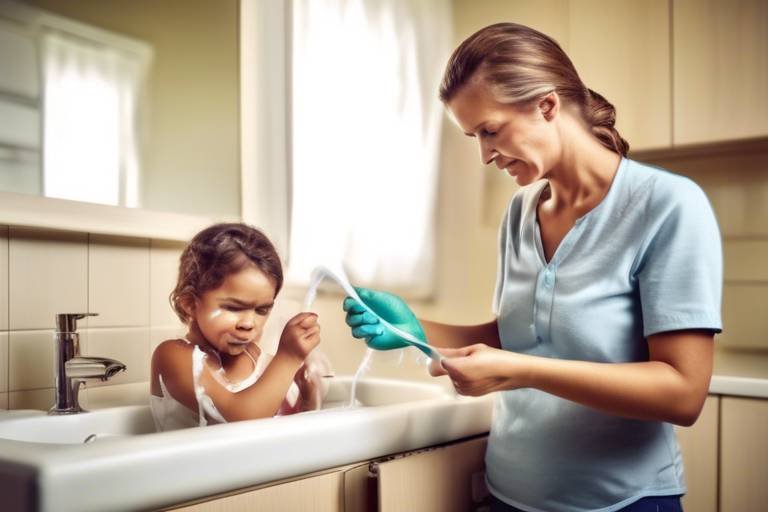Keeping Pets for Child Development and Family Health
In today's fast-paced world, the importance of family health and child development cannot be overstated. One of the most delightful ways to enhance these aspects is by welcoming a pet into the family. Pets are not just furry companions; they are incredible allies in nurturing emotional, physical, and social growth in children and adults alike. Imagine the joy of watching your child bond with a playful puppy or a curious kitten—these moments are not just cute; they are pivotal in shaping a child's personality and emotional landscape. In this article, we will delve into the myriad benefits of having pets in the family, exploring how they contribute to emotional well-being, physical health, and social skills development.
Let's face it—pets are like little bundles of joy that come with a side of unconditional love. They provide companionship that can significantly enhance emotional well-being for everyone in the household. For children, having a pet can foster empathy and a sense of responsibility. When kids take care of their pets, they learn the importance of nurturing another being, which cultivates a strong emotional foundation. Furthermore, pets can provide a sense of security, especially for children who may be feeling anxious or lonely. The simple act of petting a dog or cuddling a cat can release oxytocin, a hormone that promotes bonding and reduces stress. Can you imagine how comforting it is for a child to have a loyal friend by their side during tough times?
Owning a pet is not just good for the heart; it’s also great for the body! Pets encourage an active lifestyle, making it easier to incorporate exercise into daily routines. Whether it’s taking a dog for a walk or playing fetch in the backyard, these activities help combat obesity and related health issues. Did you know that families with pets tend to be more active? A study found that pet owners are 54% more likely to meet their daily exercise requirements compared to non-pet owners. This is a compelling reason to consider adding a furry friend to your family!
Pets are natural motivators for outdoor fun. When you have a dog, for instance, you can't just sit on the couch all day. They need walks, playtime, and exploration, which means the whole family gets to enjoy the great outdoors together. Think of it as a built-in excuse to ditch the screens and soak up some sunshine. Engaging in outdoor activities not only enhances physical fitness but also improves mental health by reducing feelings of isolation and depression. So, why not grab a leash and head out for an adventure?
Shared activities with pets create unique opportunities for family bonding. Whether it’s training a puppy together or grooming a cat, these experiences foster teamwork and strengthen relationships. It's like a mini family project where everyone has a role to play. The laughter and joy that come from these moments are invaluable, creating memories that last a lifetime. Plus, it’s a fantastic way for parents to teach their children about caring for others and working together towards a common goal.
Caring for a pet instills a sense of responsibility in children. They learn valuable life skills such as routine management, empathy, and nurturing. Imagine teaching your child to feed their pet at the same time every day—this simple task can help them understand the importance of consistency and care. Moreover, these responsibilities can translate into other areas of life, making them more prepared for future challenges.
Pets can also be excellent social facilitators. Interacting with animals helps children develop crucial social skills, such as effective communication and understanding non-verbal cues. When children play with pets, they learn to read their body language and respond appropriately, which can enhance their ability to form friendships with peers. It’s like having a furry wingman that helps break the ice in social situations!
Beyond the everyday joys, pets offer significant therapeutic benefits. They provide comfort and companionship, which can be particularly beneficial during challenging times. The presence of a pet can create a calming environment, helping to reduce stress and anxiety levels in family members. Studies have shown that interacting with pets can lower cortisol levels and increase serotonin production—two key players in mental health.
Imagine coming home after a long day and being greeted by a wagging tail or a purring cat. This simple interaction can have profound effects on your mood. Research indicates that spending time with pets can lead to a decrease in anxiety and stress, making life feel a little more manageable. It’s like having a built-in therapist that doesn’t charge by the hour!
For children with special needs, pets can be a source of unique support. They can help in developing social skills, emotional regulation, and a sense of responsibility. The unconditional love and acceptance that pets provide can enhance the quality of life for these children, making them feel valued and understood. It’s heartwarming to see how a simple bond with an animal can transform a child's experience.
- What type of pet is best for a family with young children?
Generally, dogs and cats are popular choices, but smaller pets like rabbits or guinea pigs can also be great, depending on the family's lifestyle. - How can pets help with my child's development?
Pets can enhance emotional, physical, and social development by teaching responsibility, empathy, and providing companionship. - Are there any health benefits to owning a pet?
Yes, owning a pet can lead to increased physical activity, reduced stress levels, and improved mental health.

The Emotional Benefits of Pets
Pets are more than just furry companions; they are emotional anchors that enrich our lives in countless ways. The bond between a pet and its owner can create a profound sense of companionship and unconditional love, which is especially beneficial for children. Imagine coming home after a long day, and there’s your dog, tail wagging, ready to greet you with joy. That simple act can instantly lift your spirits and make you feel valued. For children, pets can foster a sense of security and stability, which is crucial during their formative years.
Moreover, the presence of pets can significantly enhance emotional well-being. Research indicates that children who grow up with pets tend to develop higher levels of empathy and responsibility. They learn to care for another living being, which teaches them vital life skills. For instance, when a child feeds their pet or takes them for a walk, they not only fulfill a responsibility but also experience the joy that comes from nurturing. This sense of responsibility can translate into other areas of their lives, such as schoolwork and friendships.
The emotional benefits of owning a pet extend beyond just children. Adults, too, find solace in their pets. Whether it’s curling up on the couch with a cat or taking a long walk with a dog, these interactions can help reduce feelings of loneliness and isolation. In fact, studies show that pet owners often report feeling less stressed and more content overall. The simple act of petting an animal can release endorphins, which are the body’s natural stress relievers.
Additionally, pets can serve as a bridge for social interactions. For families, having a pet can open up opportunities for socialization with other pet owners. Whether it’s meeting at the dog park or chatting with neighbors about their cats, these interactions can strengthen community ties and enhance social skills for both children and adults. In essence, pets not only bring joy and love into our homes but also foster connections that can lead to lasting friendships.
In summary, the emotional benefits of having pets are immense. They provide companionship, teach responsibility, reduce stress, and enhance social interactions. As we navigate the complexities of life, having a pet by our side can make the journey all the more rewarding. So, if you’re considering adding a furry friend to your family, know that you’re not just gaining a pet; you’re enriching your emotional landscape and that of your children.

Physical Health Advantages
When we think about the impact of pets on our lives, we often focus on the emotional and social benefits. However, the of pet ownership are equally remarkable. Having a furry friend around encourages families to adopt a more active lifestyle, which is crucial in today's world where sedentary behavior is on the rise. Pets, especially dogs, require regular exercise, which translates into more outdoor activities for both children and adults. Imagine this: instead of lounging on the couch, you’re out in the park, throwing a frisbee or going for a brisk walk with your dog. This simple shift not only helps combat obesity but also promotes cardiovascular health.
Moreover, the presence of pets can lead to a decrease in stress-related conditions. The act of petting a dog or cat can lower blood pressure and create a calming effect, which is a fantastic way to mitigate the physical symptoms of stress. It's like having a natural therapist at home! The companionship of pets can also lead to a more active lifestyle, as families find themselves engaging in various activities that promote physical fitness.
Pets are natural motivators when it comes to spending time outdoors. Children and adults alike are more likely to participate in activities such as:
- Walking or jogging in the neighborhood
- Playing fetch in the park
- Exploring nature trails
- Swimming with their pets during summer
These activities not only enhance physical fitness but also provide opportunities for family bonding. When families engage in outdoor activities together, they create lasting memories and strengthen their relationships. The laughter and joy shared during these moments are invaluable.
Engaging in pet-related activities fosters teamwork and collaboration among family members. Whether it’s taking turns walking the dog or working together to train a new puppy, these shared experiences create a sense of unity. The responsibilities associated with pet care, such as feeding, grooming, and exercising, can be distributed among family members, allowing everyone to contribute. This not only strengthens familial ties but also teaches valuable lessons about cooperation and shared goals.
Caring for pets instills a sense of responsibility in children, which is a crucial aspect of their development. When kids learn to feed, groom, and exercise their pets, they are not just taking care of an animal; they are also learning about routine management and the importance of nurturing. This responsibility can translate into other areas of their lives, helping them develop skills that are essential for personal growth. For instance, children learn the significance of commitment and the rewards that come from caring for another living being. This sense of responsibility can lead to greater self-esteem and confidence.
Pets can also play a vital role in enhancing social skills, especially in children. Interacting with animals helps kids learn how to communicate effectively, not just with their pets but also with their peers. They begin to understand non-verbal cues, such as a dog’s wagging tail or a cat’s purring, which can translate into better interpersonal skills. Moreover, pet ownership can encourage friendships, as children bond over their shared love for animals. It’s not uncommon to see kids forming connections at the dog park or during playdates centered around their pets, creating a community of fellow animal lovers.
| Question | Answer |
|---|---|
| How do pets improve physical health? | Pets encourage regular exercise and outdoor activities, which help combat obesity and promote overall physical fitness. |
| Can pets help reduce stress? | Yes, interacting with pets has been shown to lower cortisol levels and increase serotonin production, leading to reduced stress and anxiety. |
| What responsibilities do children learn from pet ownership? | Children learn valuable life skills such as routine management, empathy, and nurturing through caring for their pets. |

Encouraging Outdoor Activities
When you think about pets, what often comes to mind? Fluffy tails wagging, playful barks, or perhaps the soothing purr of a cat? But beyond their adorable antics, pets play a pivotal role in encouraging families to step outside and embrace the great outdoors. Imagine a sunny Saturday morning; instead of lounging on the couch, your family is out in the park, Frisbee in hand, with your dog joyfully bounding after it. This is just one of the many scenarios where pets inspire outdoor activities, fostering a healthier lifestyle for everyone involved.
Engaging in outdoor activities with pets not only promotes physical fitness but also creates lasting memories. Whether it’s a brisk walk around the neighborhood, a hike through the woods, or a fun game of fetch, these activities can transform mundane weekends into exciting adventures. For instance, families can:
- Take daily walks, which can significantly increase cardiovascular health.
- Participate in dog parks where pets can socialize, and families can connect with others.
- Join pet-friendly community events, such as charity runs or outdoor festivals, which encourage physical activity while supporting a good cause.
Furthermore, these outdoor escapades can also serve as a wonderful opportunity to teach children about nature and the environment. As they explore parks and trails, they can learn about different plants, animals, and ecosystems, nurturing a sense of curiosity and respect for the world around them. This kind of experiential learning is invaluable and can instill a lifelong love for the outdoors.
Moreover, the act of taking care of a pet—feeding, grooming, and exercising—instills a sense of routine and responsibility in children. They learn that their furry friends depend on them for their well-being, which can be incredibly rewarding. This bond not only enhances their physical activity but also strengthens their emotional ties to their pets and family members. In essence, when families engage in outdoor activities with their pets, they are not just exercising; they are building a lifestyle that emphasizes health, connection, and joy.
In conclusion, pets are more than just companions; they are catalysts for outdoor adventures. By encouraging families to step outside together, pets help foster a culture of health, wellness, and togetherness, ultimately enriching the lives of every family member.
Q1: How can I encourage my kids to be more active with our pet?
A1: Start with short walks or play sessions that gradually increase in duration. Make it fun by incorporating games like fetch or hide-and-seek. Reward them with praise to keep their spirits high!
Q2: What types of activities can we do outdoors with our pets?
A2: There are countless activities! You can go for walks, hikes, play fetch, visit dog parks, or even participate in pet-friendly events in your community. The key is to find what excites your family and your pet!
Q3: Are there specific breeds that are better for outdoor activities?
A3: While many breeds enjoy outdoor activities, active breeds like Labrador Retrievers, Border Collies, and Beagles are often more enthusiastic about exercise. However, any pet can enjoy outdoor time with the right encouragement!
Q4: Can outdoor activities with pets help improve my child's social skills?
A4: Absolutely! Engaging in outdoor activities often leads to social interactions with other pet owners, allowing children to practice communication skills and build friendships in a relaxed environment.

Building Family Bonds
When it comes to strengthening family ties, pets can play an incredibly vital role. Imagine this: a family of four, bustling through their daily routines, often missing those precious moments of connection. Now, picture a playful dog bounding into the living room, tail wagging, ready for some fun. Suddenly, everyone is laughing, sharing stories, and engaging in activities that bring them closer together. Pets have this magical ability to break down barriers and foster a sense of unity among family members.
Engaging in pet-related activities not only creates shared experiences but also cultivates teamwork. For instance, when a family decides to take their dog for a walk, it becomes more than just exercise; it transforms into a collective adventure. Each member has a role to play: one person holds the leash, another brings treats, while the kids might take turns playing fetch. This shared responsibility encourages communication and collaboration, essential elements for any healthy relationship.
Moreover, caring for a pet requires a certain level of commitment and routine, which can further enhance family bonds. When children participate in feeding, grooming, or training their pets, they learn the importance of responsibility. This shared endeavor not only teaches valuable life skills but also creates a sense of pride and accomplishment. Families can bond over the successes and challenges of pet ownership, celebrating milestones like a pet learning a new trick or overcoming a fear.
Additionally, pets can serve as a common interest that sparks conversations and deepens connections. Families can share their thoughts, feelings, and experiences related to their pets, creating a safe space for open dialogue. Whether it’s discussing the antics of a mischievous cat or reminiscing about a beloved dog that has passed, these conversations can strengthen emotional ties and create lasting memories.
Ultimately, the presence of a pet in the household can enrich family life in countless ways. From shared responsibilities to joyful playtime, pets encourage families to come together, fostering bonds that can withstand the test of time. They remind us that, amidst the chaos of daily life, there is always room for love, laughter, and connection. So, if you're considering adding a furry (or scaly) friend to your family, know that you're not just welcoming a pet; you're opening the door to a whole new level of togetherness.
- How do pets help in building family bonds? Pets encourage shared activities, responsibility, and communication among family members, fostering stronger connections.
- What types of pets are best for families? Dogs and cats are popular choices, but smaller pets like rabbits or guinea pigs can also be great companions, depending on the family's lifestyle.
- Can pets help children with social skills? Yes, interacting with pets can enhance children's communication skills and help them understand non-verbal cues.
- Are there any specific activities that families can do with their pets? Families can enjoy walks, playtime in the yard, training sessions, or even pet-themed outings to parks or pet stores.

Promoting Routine and Responsibility
When it comes to raising children, instilling a sense of routine and responsibility is crucial. One of the most effective ways to achieve this is through pet ownership. Pets require consistent care, which naturally leads to the establishment of daily routines. Imagine waking up each morning to the gentle nudging of a furry friend, reminding you that it’s time for their breakfast and a walk. This simple act not only teaches children about the importance of meeting the needs of another living being but also reinforces the concept of responsibility.
Children learn to manage their time effectively as they juggle school, homework, and pet care. For instance, they might set aside specific times for feeding, walking, and playing with their pets. This structured approach helps them understand the value of planning and prioritization. It’s like having a mini-project that they are responsible for, allowing them to experience the satisfaction of completing tasks and seeing the positive outcomes of their efforts.
Furthermore, caring for pets can foster empathy and nurturing instincts in children. When they see their pet's excitement during playtime or their discomfort when they’re unwell, children begin to develop a deeper understanding of emotions—both their own and those of others. They learn that actions have consequences, and taking care of a pet is not just a fun activity; it’s a commitment that requires dedication and love.
In addition, the routine established through pet care can also extend to other areas of a child’s life. For example, if a child is responsible for walking the dog every evening, they may start to develop a habit of completing their homework before that time. This interconnectedness promotes a sense of discipline that can be beneficial in their academic and personal lives.
To illustrate the impact of pet care on routine and responsibility, consider the following table:
| Activity | Time Required | Skills Developed |
|---|---|---|
| Feeding the Pet | 10 minutes | Time Management, Consistency |
| Walking the Dog | 30 minutes | Physical Activity, Planning |
| Grooming | 15 minutes | Nurturing, Responsibility |
| Training Sessions | 20 minutes | Patience, Communication |
As seen in the table, each activity associated with pet care not only requires a time commitment but also fosters essential life skills. By engaging in these responsibilities, children become more aware of the needs of their pets and, in turn, develop a greater sense of accountability. This experience is invaluable, as it prepares them for future responsibilities they will encounter as they grow older.
In conclusion, promoting routine and responsibility through pet ownership is a rewarding endeavor for both children and families. It’s not just about having a pet; it’s about nurturing a bond that teaches life lessons. So, the next time you consider adding a furry member to your family, remember that you’re not just bringing home a pet; you’re also opening the door to a world of learning and growth for your children.
- What age is appropriate for children to start caring for a pet? Generally, children can start taking on small pet care responsibilities around the age of 5, but it varies depending on the child's maturity.
- How can I ensure my child is responsible for their pet? Start with small tasks and gradually increase their responsibilities as they show capability and understanding.
- What types of pets are best for teaching responsibility? Dogs and cats are popular choices, but smaller pets like guinea pigs or hamsters can also be great for younger children.
- What if my child loses interest in pet care? Encourage them by highlighting the joys of pet ownership and involving them in fun activities with the pet to reignite their interest.

Social Skills Development
When it comes to developing social skills, pets can be the ultimate teachers. Imagine a child learning to communicate effectively, not just through words but through actions and emotions, all thanks to their furry or feathery friends. Pets serve as a bridge, connecting children to the world around them. They help kids understand non-verbal cues, which is crucial for building relationships. For instance, when a child observes how a dog reacts to a gentle touch or a loud noise, they learn to interpret feelings and intentions. This kind of interaction is invaluable in shaping a child's ability to empathize and connect with others.
Moreover, pets can enhance a child's ability to make and maintain friendships. Think about it: when kids play with their pets, they often engage in activities that can be shared with peers. Whether it's a game of fetch or a simple walk in the park, these shared experiences can lead to conversations and interactions with other children who share similar interests. This not only boosts a child's confidence but also helps them find common ground with others, which is essential for forming lasting friendships.
Consider the following benefits of pet ownership on social skills development:
- Improved Communication: Children learn to express their feelings and needs more clearly when they interact with pets.
- Empathy Building: Caring for a pet teaches children to be sensitive to the needs of others, fostering a deeper understanding of emotions.
- Conflict Resolution: Playing with pets often involves negotiations, which can help children learn how to resolve conflicts amicably.
- Increased Patience: Waiting for a pet to respond or perform a trick can teach children the value of patience, a crucial social skill.
Furthermore, pets can also serve as a social catalyst. For children who may be shy or struggle with social interactions, having a pet can provide a sense of security. They can act as an icebreaker, making it easier for children to approach others. For example, a child who has a dog might find it easier to strike up a conversation with another child at the dog park, leading to new friendships.
In summary, the impact of pets on social skills development cannot be overstated. They offer a unique platform for children to learn and practice essential life skills in a safe and nurturing environment. By fostering communication, empathy, and social interactions, pets help children navigate the complex world of relationships, setting them up for success in their future endeavors.
1. How can pets help improve my child's social skills?
Pets encourage interaction, teaching children how to communicate and empathize with others. They also provide opportunities for shared activities, fostering friendships.
2. What types of pets are best for social skills development?
While any pet can contribute positively, dogs are particularly effective due to their social nature. However, cats, rabbits, and even birds can also help in developing social skills.
3. Can pets help children with social anxiety?
Yes! Pets can provide comfort and a sense of security, making it easier for children with social anxiety to engage with others.
4. How do pets teach empathy?
Caring for a pet requires understanding their needs and emotions, which helps children learn to be more empathetic towards others.
5. Are there any specific activities that can enhance social skills through pet ownership?
Activities like group dog training classes, pet playdates, or volunteering at animal shelters can significantly enhance social skills in children.

Therapeutic Effects of Pets
Pets are not just adorable companions; they also serve as powerful therapeutic allies for families. The emotional connection we share with our furry friends can profoundly influence our mental health. Imagine coming home after a long, stressful day and being greeted by a wagging tail or a soft purr. That simple interaction can turn your mood around in an instant! Studies have shown that the presence of pets can lead to significant reductions in stress and anxiety levels for both children and adults.
One of the most remarkable aspects of pet ownership is its ability to provide comfort during challenging times. When life throws curveballs—be it a tough day at work, school stress, or personal challenges—having a pet by your side can make all the difference. Pets offer a non-judgmental ear, a warm body to cuddle, and a distraction from life's worries. This bond can lead to lower cortisol levels, the hormone associated with stress, while simultaneously boosting serotonin, the feel-good chemical in our brains. It's like having a built-in therapist who’s always there for you!
Furthermore, the therapeutic benefits of pets extend beyond just emotional support. For children, especially those with special needs, pets can provide unique assistance in developing essential life skills. The responsibility of caring for a pet teaches kids about empathy, nurturing, and routine. For instance, when a child feeds their dog or cleans their cat's litter box, they learn the importance of responsibility and the joy of caring for another living being. This can be particularly beneficial for children on the autism spectrum, as pets can help them improve social skills and emotional regulation.
To illustrate the therapeutic effects of pets, consider the following table that summarizes various benefits:
| Benefit | Description |
|---|---|
| Reduced Stress | Interacting with pets has been shown to lower cortisol levels, promoting relaxation. |
| Improved Mood | Pets can increase serotonin and dopamine, leading to a happier state of mind. |
| Enhanced Social Skills | Pets can help children with social interactions, improving their ability to communicate. |
| Comfort and Companionship | Pets provide emotional support, helping individuals cope with loneliness and anxiety. |
In conclusion, the therapeutic effects of pets are undeniable. They not only enhance our emotional well-being but also contribute to our physical health and social skills development. So, if you're considering bringing a pet into your family, remember that you're not just gaining a companion; you're also investing in a healthier, happier life for everyone. Whether it's a dog, cat, or even a rabbit, the benefits they bring to your family are truly priceless.
- What types of pets are best for therapeutic effects?
While dogs and cats are the most common therapeutic pets, other animals like rabbits, guinea pigs, and even birds can provide comfort and companionship.
- How can pets help children with anxiety?
Pets can help children manage anxiety by providing a sense of security, companionship, and a calming presence during stressful situations.
- Are there any specific breeds that are better for therapy?
While any pet can offer therapeutic benefits, breeds known for their gentle and friendly nature, like Golden Retrievers and Labradors, are often preferred for therapy work.
- Can pets help with emotional regulation in children?
Yes, pets can aid in emotional regulation by providing unconditional love and teaching children how to express and manage their feelings through nurturing and care.

Reducing Anxiety and Stress
In today's fast-paced world, anxiety and stress have become all too common, affecting both children and adults alike. However, one of the most effective and heartwarming solutions lies in the paws of our furry friends. Pets, with their unconditional love and playful antics, can serve as a natural remedy for reducing anxiety and stress levels within the family. Just imagine coming home after a long day, feeling the weight of the world on your shoulders, and being greeted by a wagging tail or a soft purr. It's like a warm hug that melts away your worries!
Research has shown that interacting with pets can lead to a reduction in cortisol, the stress hormone, while simultaneously boosting serotonin and dopamine levels, which are associated with feelings of happiness and well-being. This biochemical response is not just a theory; it’s backed by numerous studies. For instance, a study conducted by the University of Missouri found that pet owners experienced a significant decrease in stress levels after spending just a few minutes with their pets. The simple act of petting a dog or cuddling a cat can create a calming effect, helping to soothe frayed nerves and lift spirits.
Moreover, pets can act as a buffer against life's challenges. When children face difficulties, whether it's at school or with friendships, pets can provide a safe space for them to express their feelings. They become confidants, listening without judgment and offering comfort through their presence. This bond can be incredibly beneficial for emotional regulation, teaching children how to cope with their feelings in a healthy way. It's as if pets possess a magical ability to sense when someone is feeling down, and they instinctively know how to provide support.
To illustrate the impact of pets on mental health, consider the following table that summarizes key benefits:
| Benefit | Description |
|---|---|
| Lowered Cortisol Levels | Regular interaction with pets can significantly reduce the levels of cortisol, helping to alleviate stress. |
| Increased Serotonin and Dopamine | Pets can boost the production of these 'feel-good' hormones, enhancing mood and promoting happiness. |
| Emotional Support | Pets provide unconditional love and companionship, which can help individuals cope with anxiety and depression. |
| Social Interaction | Walking a dog or visiting a pet-friendly place can increase social interactions, reducing feelings of isolation. |
Additionally, pets can help create a routine, which is essential for managing anxiety. Feeding, walking, and playing with a pet can provide structure to the day, giving both children and adults a sense of purpose and responsibility. This routine can be particularly beneficial for children with special needs, as it fosters predictability and security, further reducing anxiety levels.
In conclusion, the presence of pets within a family can be a transformative experience. They not only bring joy and laughter into our lives but also serve as a vital source of comfort during stressful times. So, if you're looking for a way to enhance your family's emotional well-being, consider welcoming a furry friend into your home. After all, who wouldn't want a little extra love and support in their lives?
- How do pets help reduce anxiety? Pets provide companionship and unconditional love, which can lower stress hormones and boost mood-enhancing chemicals in the brain.
- What types of pets are best for anxiety relief? Dogs and cats are commonly known for their comforting presence, but even smaller pets like rabbits and guinea pigs can provide emotional support.
- Can pets help children with special needs? Yes, pets can help children with special needs develop social skills and emotional regulation, providing a unique form of support.
- How much time should I spend with my pet to see benefits? Even a few minutes of interaction can have a positive impact, but regular, structured time spent together is ideal.

Support for Children with Special Needs
Pets can play a transformative role in the lives of children with special needs. Imagine a warm, furry friend who is always there, ready to listen without judgment and offer unconditional love. This connection can be incredibly powerful for children facing various challenges. The presence of a pet can create a safe space for these children, allowing them to express themselves freely and develop essential emotional skills.
One of the most significant benefits of having a pet is the way it helps in building social skills. For instance, children with autism often struggle with communication and social interactions. However, when they engage with a pet, they may find it easier to practice their communication skills. Pets don't require complex conversations; they respond to tone, touch, and body language, which can help children learn non-verbal cues in a low-pressure environment. This interaction can serve as a stepping stone to more complex social situations.
Moreover, pets can teach empathy and responsibility. Caring for a pet requires routine tasks such as feeding, grooming, and exercising. These responsibilities can help children with special needs understand the importance of caring for another living being. This nurturing role can enhance their ability to empathize with others, fostering a sense of connection and belonging. It's like nurturing a garden; the more attention you give, the more it flourishes.
Additionally, pets can provide a sense of routine and stability that many children with special needs benefit from. Having a consistent schedule for feeding and walking a pet can help children feel more secure and grounded. This structure can be particularly comforting during times of change or stress, offering a predictable element in their daily lives.
Furthermore, the therapeutic effects of pets are well-documented. Studies have shown that interacting with animals can significantly reduce anxiety and stress levels. For children with special needs, this can mean fewer meltdowns and a calmer emotional state. Just picture a child who is anxious about a new environment; having a pet by their side can ease that tension, acting as a comforting presence that helps them navigate their feelings.
In summary, the bond between children with special needs and their pets can lead to remarkable improvements in their emotional and social development. The love and companionship of a pet can empower these children, helping them thrive in ways that might not have been possible otherwise. It's a beautiful reminder of how the simplest things in life can have the most profound impact.
- How do pets help children with autism? Pets can improve social skills and provide emotional support, making interactions easier and less stressful.
- What types of pets are best for children with special needs? Generally, calm and gentle pets like dogs and cats are recommended, but it's essential to consider the child's specific needs and preferences.
- Can pets help reduce anxiety in children? Yes, studies show that pet interaction can lower anxiety levels and create a calming effect for children.
- How can I introduce a pet to my child with special needs? Start slowly by allowing your child to observe the pet from a distance, and gradually encourage interaction at their comfort level.
Frequently Asked Questions
- How do pets contribute to child development?
Pets play a crucial role in child development by providing companionship and teaching important life skills. They help children develop empathy, responsibility, and a sense of security within the family. When kids care for pets, they learn to nurture and understand the needs of others, which is vital for their emotional growth.
- What are the physical health benefits of having a pet?
Owning a pet encourages an active lifestyle, leading to better physical health. Regular activities like walking, playing, and exploring outdoors with pets can help combat obesity and promote fitness in both children and adults. It's a fun way for families to stay active together!
- Can pets help reduce stress and anxiety?
Absolutely! Interacting with pets has been shown to lower cortisol levels and boost serotonin production, which can significantly reduce stress and anxiety. This therapeutic effect makes pets wonderful companions, especially during tough times.
- How do pets help with social skills development in children?
Pets can enhance social skills by providing children with opportunities to communicate and build relationships. Kids learn to interpret non-verbal cues from animals, which can help them interact better with their peers. Plus, shared interests in pets can lead to new friendships!
- What unique support do pets offer to children with special needs?
Pets can be incredibly beneficial for children with special needs. They provide emotional support, help with social skills development, and can even assist in emotional regulation. The bond formed with a pet can enhance a child's quality of life in many meaningful ways.
- How can pet ownership strengthen family bonds?
Caring for pets together creates shared experiences that strengthen family relationships. Engaging in activities like walking the dog or playing with a cat fosters teamwork and communication, allowing family members to connect on a deeper level.
- What responsibilities do children learn from having pets?
Having pets teaches children valuable responsibilities, such as managing routines and caring for another living being. These experiences instill a sense of accountability and empathy, which are essential life skills that will serve them well as they grow.



















